武汉历史建筑赏析--英语
- 格式:ppt
- 大小:6.86 MB
- 文档页数:21
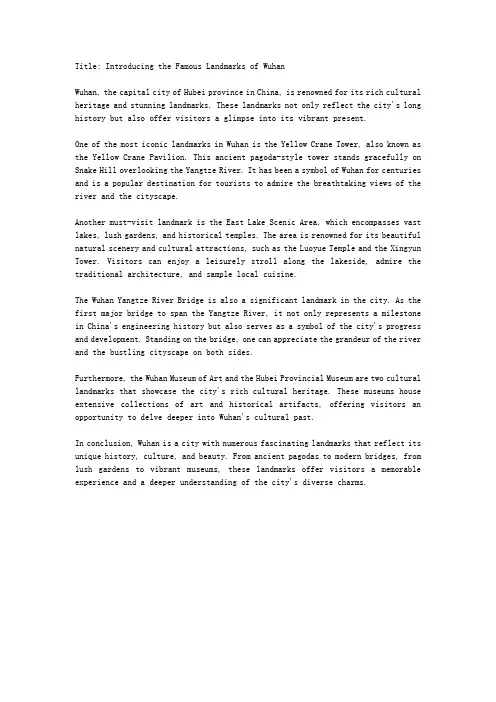
Title: Introducing the Famous Landmarks of WuhanWuhan, the capital city of Hubei province in China, is renowned for its rich cultural heritage and stunning landmarks. These landmarks not only reflect the city's long history but also offer visitors a glimpse into its vibrant present.One of the most iconic landmarks in Wuhan is the Yellow Crane Tower, also known as the Yellow Crane Pavilion. This ancient pagoda-style tower stands gracefully on Snake Hill overlooking the Yangtze River. It has been a symbol of Wuhan for centuries and is a popular destination for tourists to admire the breathtaking views of the river and the cityscape.Another must-visit landmark is the East Lake Scenic Area, which encompasses vast lakes, lush gardens, and historical temples. The area is renowned for its beautiful natural scenery and cultural attractions, such as the Luoyue Temple and the Xingyun Tower. Visitors can enjoy a leisurely stroll along the lakeside, admire the traditional architecture, and sample local cuisine.The Wuhan Yangtze River Bridge is also a significant landmark in the city. As the first major bridge to span the Yangtze River, it not only represents a milestone in China's engineering history but also serves as a symbol of the city's progress and development. Standing on the bridge, one can appreciate the grandeur of the river and the bustling cityscape on both sides.Furthermore, the Wuhan Museum of Art and the Hubei Provincial Museum are two cultural landmarks that showcase the city's rich cultural heritage. These museums house extensive collections of art and historical artifacts, offering visitors an opportunity to delve deeper into Wuhan's cultural past.In conclusion, Wuhan is a city with numerous fascinating landmarks that reflect its unique history, culture, and beauty. From ancient pagodas to modern bridges, from lush gardens to vibrant museums, these landmarks offer visitors a memorable experience and a deeper understanding of the city's diverse charms.。

游览武汉黄鹤楼Paragraph 1: Introduction to the Yellow Crane TowerThe Yellow Crane Tower, situated in Wuhan, Hubei Province, is a renowned cultural and historical landmark in China. This ancient tower, with its storied history and profound cultural significance, has attracted countless visitors from all over the world. Standing tall and elegant, it serves as a symbol of Wuhan's rich heritage and a testament to the city's vibrant past.黄鹤楼位于湖北省武汉市,是中国著名的文化历史地标之一。
这座古塔历史悠久,文化内涵深厚,吸引了来自世界各地的无数游客。
它高大而优雅,不仅是武汉丰富遗产的象征,也是这座城市繁荣过去的见证。
Paragraph 2: Historical Background and LegendsThe Yellow Crane Tower dates back to the 2nd century BC, when it was first built as a place of rest for weary travelers. Over the centuries, it has undergone numerous renovations and reconstructions, each adding to its unique charm and historical value. Legends surrounding the tower abound, the most famous being the tale of a yellow crane that carried an immortal to heaven, hence the tower's name. These legends not only enrich the tower's cultural heritage but also contribute to its enduring popularity.黄鹤楼的历史可以追溯到公元前2世纪,当时它最初是作为疲惫旅人的休憩之地而建造的。
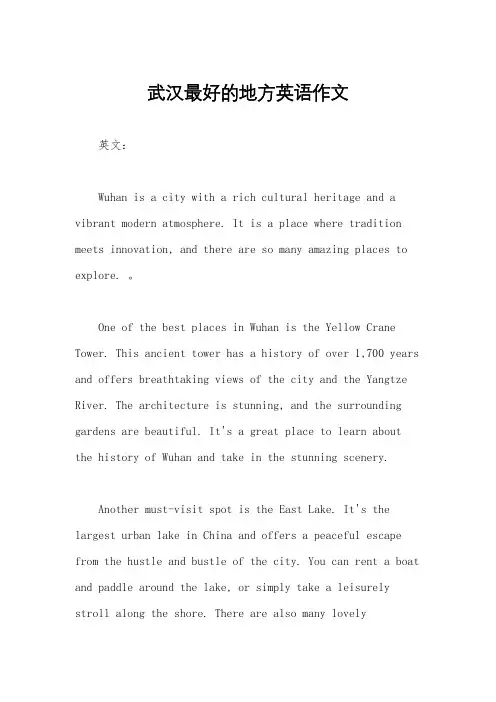
武汉最好的地方英语作文英文:Wuhan is a city with a rich cultural heritage and a vibrant modern atmosphere. It is a place where tradition meets innovation, and there are so many amazing places to explore. 。
One of the best places in Wuhan is the Yellow Crane Tower. This ancient tower has a history of over 1,700 years and offers breathtaking views of the city and the Yangtze River. The architecture is stunning, and the surrounding gardens are beautiful. It's a great place to learn about the history of Wuhan and take in the stunning scenery.Another must-visit spot is the East Lake. It's the largest urban lake in China and offers a peaceful escape from the hustle and bustle of the city. You can rent a boat and paddle around the lake, or simply take a leisurelystroll along the shore. There are also many lovelypavilions and gardens to explore, making it a perfect place to relax and unwind.For those who love food, Wuhan is a paradise. The city is famous for its delicious hot dry noodles, and there are countless street vendors and restaurants where you can try this local specialty. The bustling night markets are also a great place to sample a wide variety of tasty snacks and dishes.In addition to these attractions, Wuhan is also home to many beautiful parks, museums, and historical sites. The city has a rich cultural scene, with vibrant music and art communities. There's always something new and exciting to discover in Wuhan.中文:武汉是一个拥有丰富文化遗产和充满活力的现代氛围的城市。
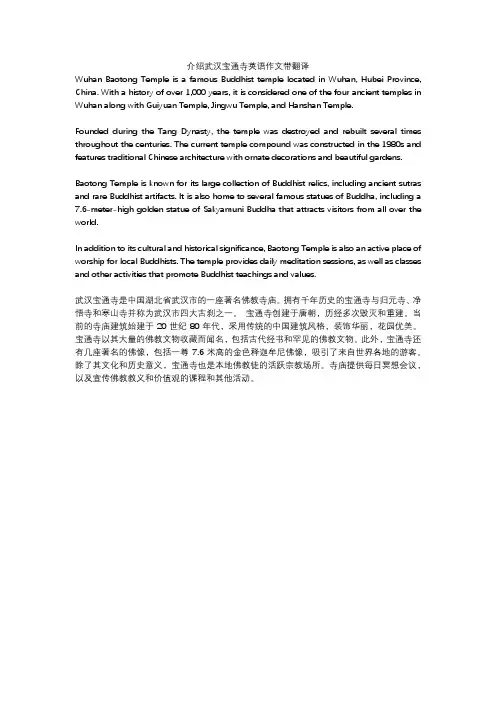
介绍武汉宝通寺英语作文带翻译Wuhan Baotong Temple is a famous Buddhist temple located in Wuhan, Hubei Province, China. With a history of over 1,000 years, it is considered one of the four ancient temples in Wuhan along with Guiyuan Temple, Jingwu Temple, and Hanshan Temple.Founded during the Tang Dynasty, the temple was destroyed and rebuilt several times throughout the centuries. The current temple compound was constructed in the 1980s and features traditional Chinese architecture with ornate decorations and beautiful gardens.Baotong Temple is known for its large collection of Buddhist relics, including ancient sutras and rare Buddhist artifacts. It is also home to several famous statues of Buddha, including a 7.6-meter-high golden statue of Sakyamuni Buddha that attracts visitors from all over the world.In addition to its cultural and historical significance, Baotong Temple is also an active place of worship for local Buddhists. The temple provides daily meditation sessions, as well as classes and other activities that promote Buddhist teachings and values.武汉宝通寺是中国湖北省武汉市的一座著名佛教寺庙。
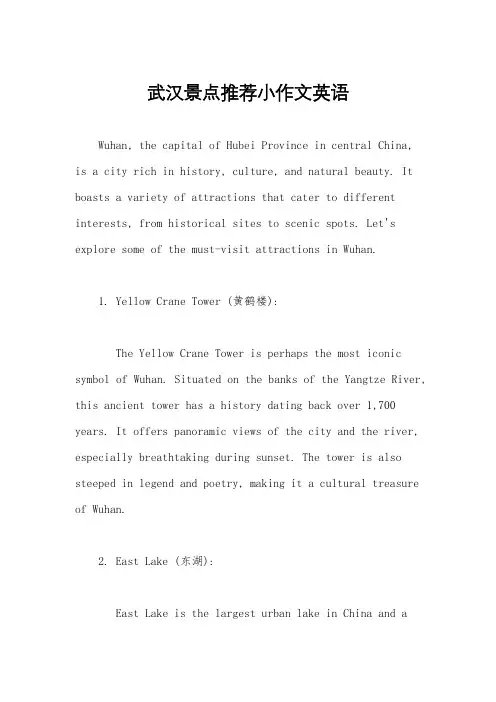
武汉景点推荐小作文英语Wuhan, the capital of Hubei Province in central China,is a city rich in history, culture, and natural beauty. It boasts a variety of attractions that cater to different interests, from historical sites to scenic spots. Let's explore some of the must-visit attractions in Wuhan.1. Yellow Crane Tower (黄鹤楼):The Yellow Crane Tower is perhaps the most iconic symbol of Wuhan. Situated on the banks of the Yangtze River, this ancient tower has a history dating back over 1,700 years. It offers panoramic views of the city and the river, especially breathtaking during sunset. The tower is also steeped in legend and poetry, making it a cultural treasure of Wuhan.2. East Lake (东湖):East Lake is the largest urban lake in China and atranquil oasis amidst the bustling city. With its picturesque scenery, lush greenery, and diverse flora and fauna, it's a perfect destination for nature lovers and outdoor enthusiasts. Visitors can enjoy leisurely strolls along the lake shore, rent boats for a relaxing cruise, or explore the various pavilions and gardens scattered around the lake.3. Hubei Provincial Museum (湖北省博物馆):For those interested in history and archaeology, the Hubei Provincial Museum is a must-visit. It houses a vast collection of artifacts spanning thousands of years of Chinese history, including ancient ceramics, jade artifacts, bronze ware, and exquisite Chu culture relics. The museum's architecture is also noteworthy, blending modern designwith traditional Chinese elements.4. Guiyuan Temple (归元寺):Guiyuan Temple is one of the four largest Buddhist temples in Hubei Province and a significant cultural andreligious site in Wuhan. Built during the Ming Dynasty, the temple features beautiful architecture, serene courtyards, and ancient trees. Visitors can explore the various halls, pavilions, and statues within the temple complex, as well as participate in Buddhist rituals and ceremonies.5. Wuhan Yangtze River Bridge (武汉长江大桥):As one of the first bridges to span the Yangtze River, the Wuhan Yangtze River Bridge holds historical significance as well as architectural marvel. Completed in 1957, it played a crucial role in connecting the northern and southern parts of China. Visitors can walk or cycle across the bridge, admiring its distinctive double-deck design and enjoying panoramic views of the river and the city skyline.6. Hubu Alley (户部巷):Hubu Alley is a bustling pedestrian street renowned for its local delicacies and vibrant atmosphere. Here, visitors can sample a wide variety of traditional Wuhansnacks and dishes, such as hot dry noodles (热干面), duck neck (鸭脖子), and bean-skin jelly (豆皮). The livelystreet is also lined with shops selling souvenirs, handicrafts, and local specialties, making it a perfect place to experience the culinary delights of Wuhan.7. Tingtao Scenic Area (听涛景区):Located on the southern bank of the Yangtze River, Tingtao Scenic Area is renowned for its natural beauty and cultural heritage. Visitors can stroll along the riverbank, enjoying the soothing sound of lapping waves and gentle breeze. The area is also dotted with ancient temples, pavilions, and gardens, providing a peaceful retreat from the hustle and bustle of the city.These are just a few highlights of the many attractions that Wuhan has to offer. Whether you're interested in history, culture, nature, or cuisine, Wuhan has something for everyone to enjoy. Come and explore this vibrant city to experience its unique charm and beauty.。
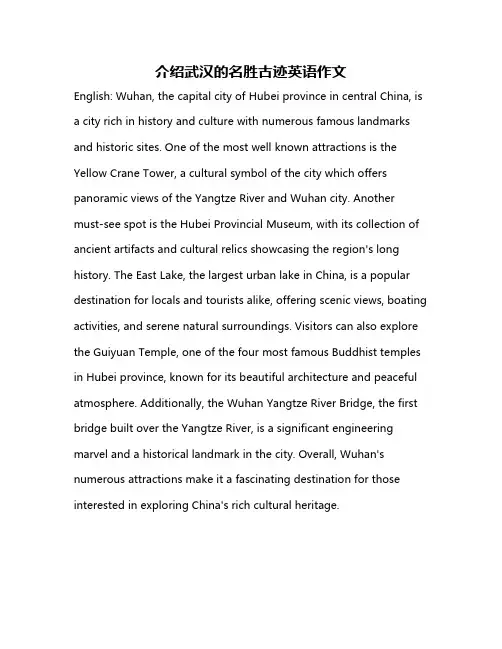
介绍武汉的名胜古迹英语作文English: Wuhan, the capital city of Hubei province in central China, is a city rich in history and culture with numerous famous landmarks and historic sites. One of the most well known attractions is the Yellow Crane Tower, a cultural symbol of the city which offers panoramic views of the Yangtze River and Wuhan city. Another must-see spot is the Hubei Provincial Museum, with its collection of ancient artifacts and cultural relics showcasing the region's long history. The East Lake, the largest urban lake in China, is a popular destination for locals and tourists alike, offering scenic views, boating activities, and serene natural surroundings. Visitors can also explore the Guiyuan Temple, one of the four most famous Buddhist temples in Hubei province, known for its beautiful architecture and peaceful atmosphere. Additionally, the Wuhan Yangtze River Bridge, the first bridge built over the Yangtze River, is a significant engineering marvel and a historical landmark in the city. Overall, Wuhan's numerous attractions make it a fascinating destination for those interested in exploring China's rich cultural heritage.Translated content: 武汉,位于中国中部湖北省省会城市,是一座历史悠久、文化丰富的城市,拥有许多著名的地标和历史遗迹。
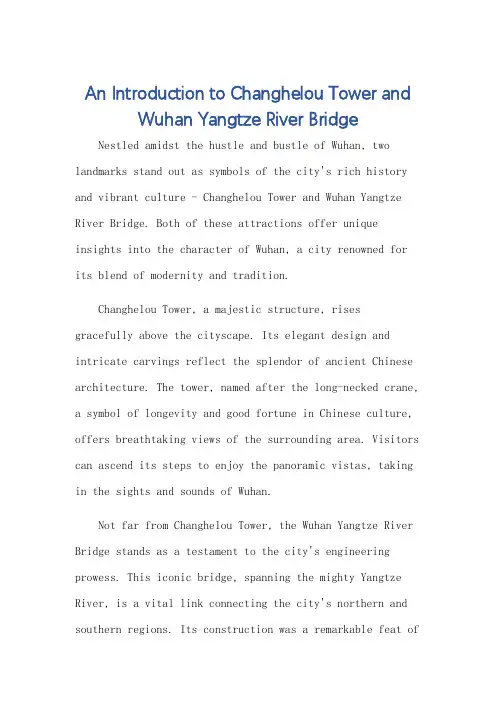
An Introduction to Changhelou Tower and Wuhan Yangtze River BridgeNestled amidst the hustle and bustle of Wuhan, two landmarks stand out as symbols of the city's rich history and vibrant culture - Changhelou Tower and Wuhan Yangtze River Bridge. Both of these attractions offer unique insights into the character of Wuhan, a city renowned for its blend of modernity and tradition.Changhelou Tower, a majestic structure, risesgracefully above the cityscape. Its elegant design and intricate carvings reflect the splendor of ancient Chinese architecture. The tower, named after the long-necked crane, a symbol of longevity and good fortune in Chinese culture, offers breathtaking views of the surrounding area. Visitors can ascend its steps to enjoy the panoramic vistas, taking in the sights and sounds of Wuhan.Not far from Changhelou Tower, the Wuhan Yangtze River Bridge stands as a testament to the city's engineering prowess. This iconic bridge, spanning the mighty Yangtze River, is a vital link connecting the city's northern and southern regions. Its construction was a remarkable feat ofengineering, overcoming numerous challenges to create a structure that stands as a symbol of progress and unity.Walking along the bridge, one can appreciate its grandeur and the magnitude of the task accomplished. The views of the river and the cityscape are truly captivating, providing a unique perspective on Wuhan's beauty.Both Changhelou Tower and Wuhan Yangtze River Bridge offer visitors a chance to delve deeper into the heart of Wuhan. Whether admiring the intricate details of the toweror marveling at the engineering marvel of the bridge, these attractions provide a window into the city's rich cultural heritage and vibrant present.For those interested in Chinese history and culture, Changhelou Tower offers an intriguing glimpse into the past. Its traditional design and carvings offer a window into the intricate artistry of ancient China. The tower is also a popular spot for photography, allowing visitors to capture stunning images that perfectly encapsulate the essence of Wuhan.Meanwhile, the Wuhan Yangtze River Bridge is a must-visit for anyone fascinated by engineering and architecture.Its impressive length and sturdy construction are a testament to human ingenuity and determination. Walking across the bridge, visitors can appreciate the magnitude of the task accomplished and marvel at the beauty of the surrounding landscape.In conclusion, Changhelou Tower and Wuhan Yangtze River Bridge are two of Wuhan's most iconic attractions. They offer visitors a unique opportunity to explore the city's rich cultural heritage and appreciate its vibrant modern face. Whether admiring the grandeur of the tower or wandering across the bridge, these landmarks are sure to leave a lasting impression on anyone who visits.**武汉长鹤楼与长江大桥介绍**坐落于繁华武汉的怀抱之中,长鹤楼与武汉长江大桥作为城市的两大标志,以各自独特的姿态展示着这座城市丰富的历史底蕴和生机勃勃的文化。
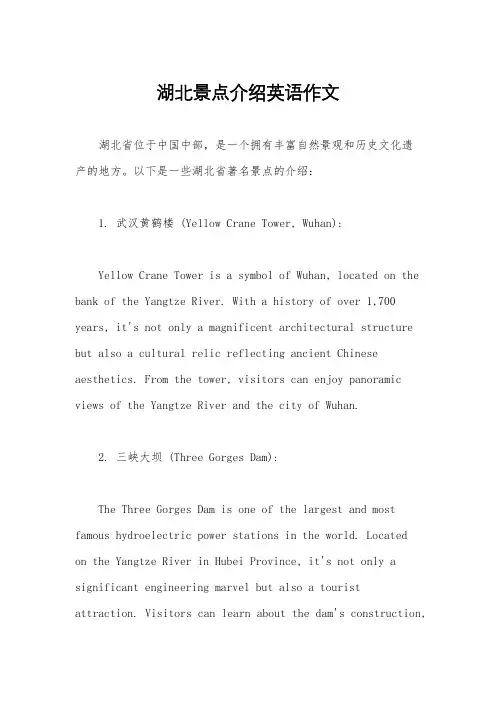
湖北景点介绍英语作文湖北省位于中国中部,是一个拥有丰富自然景观和历史文化遗产的地方。
以下是一些湖北省著名景点的介绍:1. 武汉黄鹤楼 (Yellow Crane Tower, Wuhan):Yellow Crane Tower is a symbol of Wuhan, located on the bank of the Yangtze River. With a history of over 1,700 years, it's not only a magnificent architectural structure but also a cultural relic reflecting ancient Chinese aesthetics. From the tower, visitors can enjoy panoramic views of the Yangtze River and the city of Wuhan.2. 三峡大坝 (Three Gorges Dam):The Three Gorges Dam is one of the largest and most famous hydroelectric power stations in the world. Locatedon the Yangtze River in Hubei Province, it's not only a significant engineering marvel but also a tourist attraction. Visitors can learn about the dam's construction,its environmental impact, and its role in flood control and electricity generation.3. 恩施大峡谷 (Enshi Grand Canyon):Enshi Grand Canyon is a breathtaking natural wonder located in Enshi Tujia and Miao Autonomous Prefecture. It features steep cliffs, lush vegetation, and a meandering river flowing through the canyon. Visitors can explore the canyon by hiking along its trails, admiring its stunning scenery, and experiencing the local Tujia culture.4. 武当山 (Wudang Mountains):Wudang Mountains, located in Shiyan City, are famousfor their Taoist heritage and breathtaking natural beauty. The mountains are home to numerous ancient Taoist temples, pavilions, and palaces, including the renowned Wudang Palace. Visitors can immerse themselves in Taoist culture, practice Tai Chi, and enjoy the tranquil atmosphere of this sacred mountain range.5. 黄鹤楼 (Yellow Crane Tower):Yellow Crane Tower is a symbol of Wuhan, located on the bank of the Yangtze River. With a history of over 1,700 years, it's not only a magnificent architectural structure but also a cultural relic reflecting ancient Chinese aesthetics. From the tower, visitors can enjoy panoramic views of the Yangtze River and the city of Wuhan.6. 神农架 (Shennongjia):Shennongjia is a UNESCO World Heritage Site known for its pristine forests, diverse wildlife, and unique ecosystems. It's a paradise for nature lovers and outdoor enthusiasts, offering opportunities for hiking, wildlife watching, and exploring ancient forests. Shennongjia is also famous for being the supposed birthplace of Shennong, the mythical Chinese emperor who discovered the properties of medicinal plants.这些景点只是湖北省丰富旅游资源的一部分。
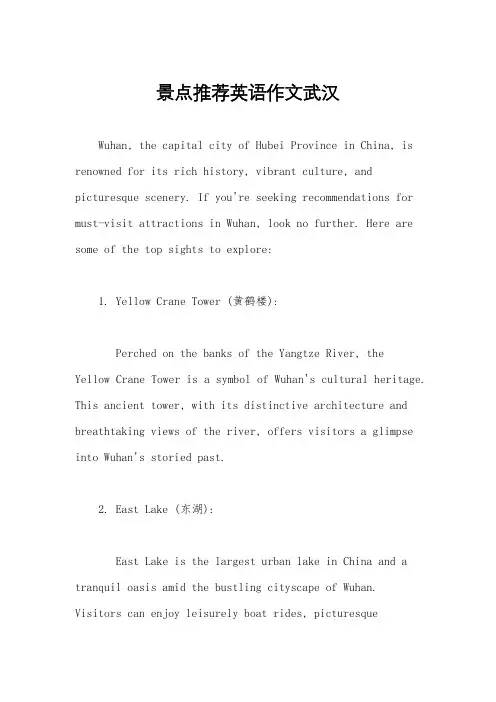
景点推荐英语作文武汉Wuhan, the capital city of Hubei Province in China, is renowned for its rich history, vibrant culture, and picturesque scenery. If you're seeking recommendations for must-visit attractions in Wuhan, look no further. Here are some of the top sights to explore:1. Yellow Crane Tower (黄鹤楼):Perched on the banks of the Yangtze River, theYellow Crane Tower is a symbol of Wuhan's cultural heritage. This ancient tower, with its distinctive architecture and breathtaking views of the river, offers visitors a glimpse into Wuhan's storied past.2. East Lake (东湖):East Lake is the largest urban lake in China and a tranquil oasis amid the bustling cityscape of Wuhan.Visitors can enjoy leisurely boat rides, picturesquewalking trails, and lush greenery, making it a perfect escape from the urban hustle and bustle.3. Hubei Provincial Museum (湖北省博物馆):For history enthusiasts, a visit to the Hubei Provincial Museum is a must. Home to a vast collection of artifacts spanning thousands of years of Chinese history, including ancient bronze vessels, jade artifacts, and intricate pottery, the museum offers insights into the region's rich cultural heritage.4. Guiyuan Temple (归元禅寺):Guiyuan Temple, dating back to the Qing Dynasty, is one of the most revered Buddhist temples in Wuhan. With its serene atmosphere, exquisite architecture, and beautiful gardens, it provides visitors with an opportunity for spiritual reflection and cultural appreciation.5. Wuhan Yangtze River Bridge (武汉长江大桥):As an iconic landmark of Wuhan, the Yangtze River Bridge is not only a marvel of engineering but also offers stunning views of the Yangtze River and the city skyline. A walk or drive across this bridge is an essential experience for any visitor to Wuhan.6. Hubu Alley (户部巷):Hubu Alley is a bustling food street in Wuhan, offering a diverse array of local delicacies and street foods. From spicy hot dry noodles to delectable snacks like Re-gan mian (热干面) and Doupi (豆皮), visitors can indulge in a culinary adventure that showcases the unique flavorsof Wuhan cuisine.7. Cherry Blossom Garden (樱花园):During the spring season, the Cherry Blossom Gardenin Wuhan becomes a picturesque sea of pink and white blooms. Visitors can stroll along winding pathways lined withcherry blossom trees in full bloom, creating a stunning backdrop for memorable photos and moments of tranquility.8. Wuhan Botanical Garden (武汉植物园):Nature lovers will appreciate the beauty of the Wuhan Botanical Garden, home to a diverse collection of plant species from China and around the world. With its lush gardens, tranquil ponds, and scenic landscapes, it offers a peaceful retreat from the urban hustle.These are just a few highlights of what Wuhan has to offer. Whether you're interested in history, culture, nature, or gastronomy, Wuhan has something to captivate every traveler's heart and soul.。
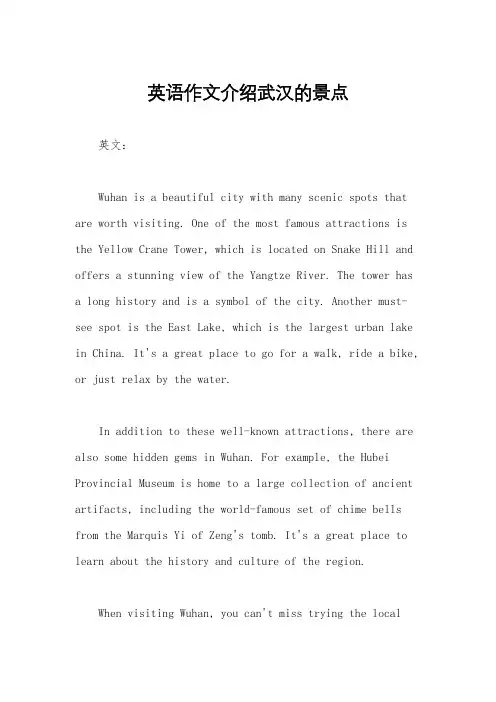
英语作文介绍武汉的景点英文:Wuhan is a beautiful city with many scenic spots that are worth visiting. One of the most famous attractions is the Yellow Crane Tower, which is located on Snake Hill and offers a stunning view of the Yangtze River. The tower has a long history and is a symbol of the city. Another must-see spot is the East Lake, which is the largest urban lake in China. It's a great place to go for a walk, ride a bike, or just relax by the water.In addition to these well-known attractions, there are also some hidden gems in Wuhan. For example, the Hubei Provincial Museum is home to a large collection of ancient artifacts, including the world-famous set of chime bells from the Marquis Yi of Zeng's tomb. It's a great place to learn about the history and culture of the region.When visiting Wuhan, you can't miss trying the localcuisine. Hot dry noodles, Re Gan Mian, and Doupi are someof the most popular dishes. The food here is delicious and affordable, and you can find it at small local restaurants as well as fancy dining establishments.Overall, Wuhan has a lot to offer for tourists. Whether you're interested in history, nature, or food, there's something for everyone in this vibrant city.中文:武汉是一个美丽的城市,有许多值得参观的景点。
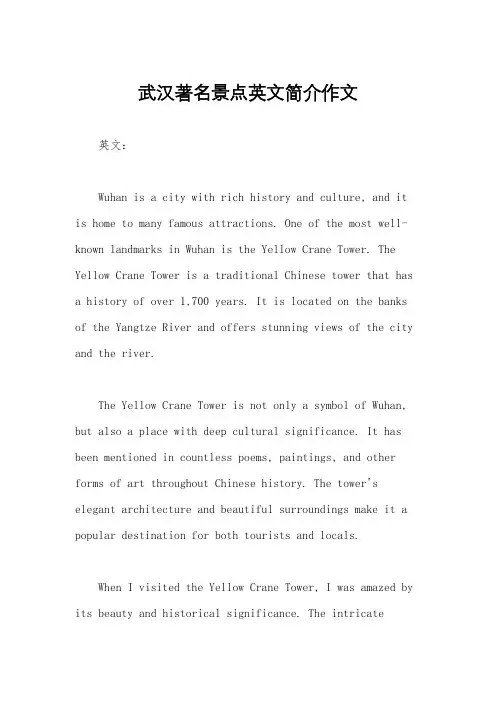
武汉著名景点英文简介作文英文:Wuhan is a city with rich history and culture, and it is home to many famous attractions. One of the most well-known landmarks in Wuhan is the Yellow Crane Tower. The Yellow Crane Tower is a traditional Chinese tower that has a history of over 1,700 years. It is located on the banks of the Yangtze River and offers stunning views of the city and the river.The Yellow Crane Tower is not only a symbol of Wuhan, but also a place with deep cultural significance. It has been mentioned in countless poems, paintings, and other forms of art throughout Chinese history. The tower's elegant architecture and beautiful surroundings make it a popular destination for both tourists and locals.When I visited the Yellow Crane Tower, I was amazed by its beauty and historical significance. The intricatecarvings and decorations on the tower were truly impressive, and the panoramic views from the top of the tower were breathtaking. I also enjoyed learning about the legends and stories associated with the tower, which added to theoverall experience.In addition to the tower itself, the surroundinggardens and parks are also worth exploring. I spent some time wandering through the lush greenery and taking in the peaceful atmosphere. There were also several souvenir shops and tea houses where I could relax and enjoy sometraditional Chinese tea.Overall, my visit to the Yellow Crane Tower was a memorable experience. It was a great opportunity to immerse myself in Chinese history and culture, and I would highly recommend it to anyone visiting Wuhan.中文:武汉是一个历史悠久、文化丰富的城市,拥有许多著名景点。
武汉地标建筑英文作文英文回答:Wuhan, the capital city of Hubei Province in China, is home to many landmark buildings that showcase the city's rich cultural and historical heritage. Here are some of the most famous landmarks in Wuhan:1. Yellow Crane Tower (黄鹤楼): This tower is a symbol of Wuhan and is located on the banks of the Yangtze River. It was built in the 3rd century and has been destroyed and rebuilt many times over the centuries. The tower is famous for its beautiful architecture and stunning views of the river and the city.2. Wuhan Yangtze River Bridge (武汉长江大桥): This bridge is the first bridge to cross the Yangtze River in Wuhan and is one of the longest bridges in the world. It was built in 1957 and has become a symbol of the city's modernization and development.3. East Lake (东湖): This is the largest urban lake in China and is located in the eastern part of Wuhan. It is a popular tourist destination and is known for its beautiful scenery and cultural attractions.4. Hubei Provincial Museum (湖北省博物馆): This museum is located in the Wuchang district of Wuhan and is one of the largest museums in China. It houses over 200,000 cultural relics and artifacts, including ancient pottery, bronze ware, and jade.5. Wuhan University (武汉大学): This university is one of the most prestigious universities in China and is located in the Wuchang district of Wuhan. It is known for its beautiful campus and academic excellence.中文回答:武汉是中国湖北省的省会城市,拥有许多标志性建筑,展示了这座城市丰富的文化和历史遗产。
武汉地标建筑英文作文英文:Wuhan is a city with a rich history and culture, and it is home to many iconic landmarks. In this article, I will introduce some of the most famous buildings in Wuhan.Firstly, there is the Yellow Crane Tower. This tower is a symbol of Wuhan and is one of the most famous buildingsin China. It was first built in the third century and has been rebuilt many times over the centuries. Today, it stands at 51.4 meters tall and offers stunning views of the city.Secondly, there is the Wuhan Yangtze River Bridge. This bridge is the first bridge over the Yangtze River and is an important transportation hub in Wuhan. It was built in 1957 and has a total length of 1670 meters. The bridge is also known as the "First Bridge of China" and is a symbol of the country's modernization.Finally, there is the Wuhan International Plaza. This building is a modern skyscraper and is the tallest building in Wuhan, standing at 438 meters tall. It is a mixed-use building that includes offices, hotels, and apartments. The building is a symbol of Wuhan's rapid development in recent years.中文:武汉是一个拥有丰富历史和文化的城市,拥有许多标志性的地标建筑。
介绍武汉的名胜古迹英语作文English:Wuhan, known as the "River City," is a city with a rich history and a plethora of famous landmarks and historical sites. One of the most well-known attractions in Wuhan is the Yellow Crane Tower, a historic tower that is a symbol of the city. Built originally in the 3rd century, the tower has been destroyed and rebuilt numerous times throughout its history, but it remains a treasured cultural relic and a must-see for visitors to Wuhan. Another iconic site in Wuhan is the Hubei Provincial Museum, which boasts a vast collection of ancient artifacts, including the world-renowned set of chime bells from the Marquis Yi of Zeng's tomb. Visitors can also explore the Guiyuan Temple, one of the four largest Buddhist temples in Hubei Province, and stroll around its serene gardens. Additionally, the East Lake is the largest urban lake in China and is a popular destination for locals and tourists alike, offering beautiful scenery, boat rides, and various recreational activities. These are just a few of the many historical and cultural attractions that make Wuhan a fascinating and enchanting city to visit.Translated content:武汉被称为“江城”,是一个历史悠久并且拥有许多著名地标和历史遗迹的城市。
武汉老建筑英语作文Title: Preserving the Historic Charm: Exploring Wuhan's Old Buildings。
Wuhan, the capital city of Hubei Province in China, boasts a rich cultural heritage, with its old buildings serving as tangible reminders of its storied past. These architectural treasures, spanning various periods and styles, not only add character to the city but also serve as vital links to its history and identity.One of the prominent features of Wuhan's old buildings is their architectural diversity. From traditional Chinese courtyard houses to Western-style mansions, each structure narrates a unique story of its era. For instance, the Hanyang Zao Art District, located in the heart of Wuhan, showcases a blend of industrial heritage and contemporary artistry, offering a glimpse into the city's transformation over time.Preserving these old buildings is imperative for several reasons. Firstly, they serve as invaluable educational resources, offering insights into the architectural techniques and lifestyles of bygone eras. Additionally, they contribute to the city's cultural landscape, attracting tourists and fostering a sense of pride among residents.Furthermore, the conservation of old buildings promotes sustainable urban development. Rather than demolishing and rebuilding, refurbishing existing structures reduces environmental impact and conserves resources. It also revitalizes neighborhoods, spurring economic growth through heritage tourism and cultural activities.However, preserving Wuhan's old buildings presents several challenges. Urbanization and rapid development often prioritize modernization over heritage conservation, leading to the neglect and deterioration of historic structures. Additionally, inadequate funding and expertise hinder restoration efforts, jeopardizing the integrity of these architectural treasures.To address these challenges, collaborative efforts between government agencies, preservationists, and thelocal community are essential. Establishing comprehensive heritage protection policies and incentives can incentivize property owners to maintain and restore old buildings. Moreover, investing in heritage education and vocational training can cultivate a skilled workforce capable of preserving Wuhan's architectural legacy.Public awareness and engagement are also crucial components of successful preservation initiatives. Through advocacy campaigns, cultural events, and heritage tours, residents and visitors alike can develop a deeper appreciation for Wuhan's old buildings and the need to protect them for future generations.In conclusion, Wuhan's old buildings are not merely structures of brick and mortar but repositories of history, culture, and identity. Preserving these architectural gems is not only a testament to our respect for the past but also an investment in the future. By embracing sustainableconservation practices and fostering community involvement, we can ensure that Wuhan's old buildings continue to enrich our lives and inspire generations to come.。
介绍武汉的长鹤楼和长江大桥英语作文Wuhan's Changhe Tower and Yangtze River BridgeWuhan, the capital city of Hubei province in central China, is renowned for its rich history and stunning landmarks. Two of the most iconic structures in the city are the Changhe Tower and the Yangtze River Bridge, both of which have become symbols of Wuhan's cultural and architectural heritage.The Changhe Tower, also known as the Yellow Crane Tower, is a magnificent pagoda-style structure that has stood tall on the banks of the Yangtze River for centuries. The tower's history can be traced back to the 3rd century AD, when it was first constructed as a military watchtower. Over the years, the tower has undergone numerous reconstructions and renovations, with each iteration reflecting the architectural styles and cultural influences of its respective era.The current Changhe Tower, which stands at a height of 51.4 meters (168.5 feet), was rebuilt in 1868 after being destroyed by fire. The tower's striking yellow exterior, adorned with intricate carvings and decorations, is a testament to the skilled craftsmanship of the artisans who created it. The tower's design incorporates elements oftraditional Chinese architecture, including the upward-curving roofs and the use of wooden beams and columns.One of the most remarkable features of the Changhe Tower is its panoramic views of the Yangtze River and the surrounding cityscape. Visitors can ascend to the top of the tower via a series of winding staircases, where they are rewarded with breathtaking vistas of the river and the city's skyline. On a clear day, the views stretch as far as the distant mountains that frame the horizon.In addition to its architectural significance, the Changhe Tower also holds immense cultural and historical importance for the people of Wuhan. The tower has been the subject of countless poems, paintings, and literary works, and it has played a central role in the city's cultural and social life for centuries. The tower is a popular tourist destination, attracting visitors from all over the world who come to marvel at its beauty and learn about its rich history.Another iconic landmark in Wuhan is the Yangtze River Bridge, a remarkable engineering feat that spans the mighty Yangtze River. Completed in 1957, the bridge was the first of its kind to be built across the Yangtze, a river renowned for its treacherous currents and unpredictable weather conditions.The Yangtze River Bridge is a double-decker structure, with theupper deck carrying road traffic and the lower deck accommodating railway lines. The bridge's design, which incorporates both suspension and cantilever elements, is a testament to the ingenuity and skill of the engineers who conceived and constructed it.At a total length of 1.67 kilometers (1.04 miles), the Yangtze River Bridge is a truly impressive structure. Its central span, which measures 1,092 meters (3,583 feet), is one of the longest suspension bridge spans in the world. The bridge's towering pylons, which riseto a height of 95 meters (312 feet), are a dominant feature of the Wuhan skyline, visible from many vantage points throughout the city.The Yangtze River Bridge has not only transformed the city's transportation infrastructure but also played a crucial role in the economic and social development of Wuhan. The bridge has facilitated the movement of people and goods across the Yangtze, connecting the city's eastern and western districts and fostering greater economic integration and growth.Beyond its practical significance, the Yangtze River Bridge has also become an iconic symbol of Wuhan's resilience and ingenuity. The bridge's construction, which was completed in just four years, was a remarkable feat of engineering that captured the imagination of the Chinese people and the international community.Today, the Yangtze River Bridge is a popular tourist attraction, drawing visitors from around the world who come to marvel at its impressive engineering and take in the stunning views of the Yangtze River and the Wuhan skyline. The bridge's illumination at night, with its elegant lighting displays, adds to the structure's visual appeal and has become a signature feature of the Wuhan landscape.In conclusion, the Changhe Tower and the Yangtze River Bridge are two of Wuhan's most iconic and celebrated landmarks. These structures not only embody the city's rich history and cultural heritage but also represent the ingenuity, resilience, and ambition of the people of Wuhan. As Wuhan continues to evolve and grow, these landmarks will undoubtedly remain at the heart of the city's identity, inspiring awe and wonder in all who experience them.。
武汉遗址介绍英文作文Wuhan Ruins Introduction。
Wuhan, a city with a long history, is home to many ancient ruins that have witnessed the changes and development of the city over the centuries. These ruins are not only important historical and cultural sites, but also popular tourist attractions for people to explore and learn about the city's past.The ruins in Wuhan are diverse in nature, ranging from ancient city walls and gates to temples and tombs. Eachruin has its own unique story to tell, offering visitors a glimpse into the rich history and cultural heritage of the city.One of the most well-known ruins in Wuhan is the Yellow Crane Tower, a historic tower that dates back over 1,700 years. It is not only a symbol of the city, but also a place where visitors can enjoy panoramic views of theYangtze River and learn about the legends and folklore associated with the tower.Another notable ruin in Wuhan is the Guiyuan Temple, a Buddhist temple that was first built over 350 years ago. The temple is renowned for its exquisite architecture, beautiful gardens, and valuable collection of Buddhist scriptures and artifacts.In addition to these famous ruins, Wuhan is also home to many lesser-known ruins that are equally fascinating and worth exploring. From ancient city gates to old residential neighborhoods, these ruins offer a glimpse into the daily life and customs of the people who lived in Wuhan in the past.Overall, the ruins in Wuhan are not only important historical and cultural landmarks, but also valuable resources for people to learn about the city's past and appreciate its rich heritage. Whether you are a history enthusiast or simply curious about the city's roots,exploring the ruins in Wuhan is a rewarding and enlightening experience.。